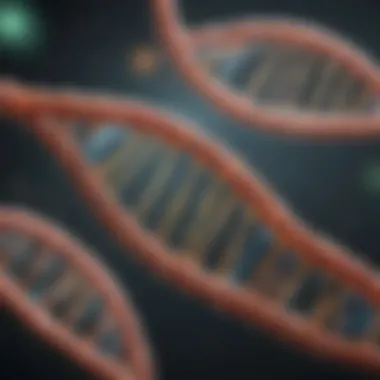MTDNA Analysis: Insights into Evolution and Health


Intro
Mitochondrial DNA (mtDNA) analysis serves as a vital avenue in deciphering both human history and biological complexities. Derived from the remarkably efficient energy factories within our cells, mitochondria are not just powerhouses but also carriers of genetic information passed down maternally. This unique inheritance pattern equips researchers with tools to trace ancestral lineages and delve into evolutionary trajectories. While often overshadowed by nuclear DNA studies, mtDNA has carved its niche in various scientific domains, from tracing family ties to advancing forensic investigations.
The relevance of mtDNA analysis in our understanding of human biology cannot be overstated. This powerful method does not just unveil how we are connected to one another but also offers insights into how our species has adapted over millennia. With advancements in technology enhancing the precision and efficiency of mtDNA studies, today’s scientists are well-equipped to sift through heaps of genetic data, extracting narratives that shape our understanding of health, ancestry, and much more.
Given its multifaceted importance, this exploration of mtDNA analysis will embark on a journey through its methodologies, future directions, and ethical considerations. We will shine a light on how this genetic analysis is not merely a scientific endeavor but a lens through which we can view our past, present, and potential future.
Prelude to Mitochondrial DNA
Mitochondrial DNA (mtDNA) serves as a cornerstone in the study of genetics, evolution, and various medical fields. Understanding this component of our genetic makeup offers a wealth of insights into not just our ancestry, but also the functioning of our cells. Mitochondria are often referred to as the powerhouses of the cell, and their unique DNA reflects a fascinating blend of our evolutionary past and present biological functions.
The significance of mtDNA lies in its ability to elucidate the matrilineal ancestry of individuals. Since mtDNA is maternally inherited, it provides a clear lineage back through generations. This aspect is crucial for fields ranging from anthropology to genetic counseling, as it contributes richly to our understanding of human migration patterns and population dynamics.
Also important is the structural uniqueness of mtDNA. Unlike nuclear DNA, which is linear and found in pairs, mtDNA is circular and exists in multiple copies within each mitochondrion. This distinct structure not only influences how mutations occur but also impacts how mtDNA can be analyzed and utilized in research.
The various methodologies employed in the analysis of mitochondiral DNA have created pathways for continued exploration in countless fields. As we delve deeper into this subject, the relevance of mtDNA in modern science and its implications for our health become increasingly evident. A detailed understanding of this topic prompts questions about its implications in health-related matters such as mitochondrial diseases and cancer.
"Mitochondrial DNA analysis is not just a tool; it is a window into our past and a key to understanding our future."
By examining mtDNA, researchers can unveil the historical connections between populations and the biological mechanisms that underpin various human health issues. The journey through mtDNA analysis promises a comprehensive perspective on human biology, evolution, and the complexities of genetic research, setting the stage for a robust discussion in the following sections.
Definition and Structure of mtDNA
To comprehend the essence of mtDNA, one must first grasp its definition and structure. Mitochondrial DNA refers to the genetic material found within mitochondria, the organelles responsible for producing energy in cells. Unlike chromosomal DNA found in the nucleus, mtDNA is distinct for several reasons:
- Circular Shape: It is organized in a circular form, making it structurally different from the linear chromosomes located in the nucleus.
- Maternally Inherited: mtDNA is passed down exclusively from mother to offspring, creating a unique transmission pathway for genetic information.
- Multiple Copies: A single mitochondrion can contain several copies of mtDNA, which makes it more abundant and easier to extract for analysis in comparison to nuclear DNA.
The mtDNA molecule is compact and encodes 37 genes essential for mitochondrial function, primarily involved in energy production. This functional focus uniquely positions mtDNA as a subject of study in both evolutionary biology and human health.
Historical Context and Discovery
The discovery of mtDNA dates back to the mid-20th century. Initial observations by scientists focused on the characteristics of mitochondria, but it wasn't until researchers began sequencing mitochondrial genomes in the 1980s that a clearer understanding emerged.
Several landmark moments define the history of mtDNA research:
- Documentation of its Characteristics: Early studies articulated how mtDNA differed in structure and function from nuclear DNA and highlighted its maternal inheritance.
- Development of Sequencing Techniques: By the early 1990s, advancements in sequencing technology allowed for a deeper examination of mtDNA, which in turn paved the way for its applications in anthropology and genetic disorders.
- Role in Human Evolution: The concept of using mtDNA in tracing human evolution gained popularity as it provided insights into ancient human migrations, enriching the narrative of our shared history.
Understanding the historical background gives context to the applications we observe today. From tracing ancestry using mtDNA to uncovering clues in forensic investigations, the story of how mtDNA analysis evolved is as intriguing as the science itself.
Scientific Importance of mtDNA
Mitochondrial DNA, commonly referred to as mtDNA, holds a crucial position in various scientific fields. Its significance extends beyond the mere necessity of understanding cellular processes; it touches upon evolutionary theories, health paradigms, and forensic investigations. This section navigates through the layered importance of mtDNA and sheds light on specific elements, benefits, and the broader implications in various domains.
Role in Cellular Energy Production
The primary function of mtDNA lies in its central role in cellular energy production. Mitochondria are often dubbed the cell's powerhouse, producing adenosine triphosphate (ATP) through oxidative phosphorylation.
- Efficient Energy Generation: The genes encoded in mtDNA are essential for synthesizing proteins vital to this process.
- Dependency on mtDNA: Unlike nuclear DNA, which is inherited from both parents, mtDNA is maternally inherited and passed down generations. This unique aspect makes mtDNA a reliable marker for tracing maternal lineage. Mapping these genes is essential not just for understanding energy metabolism but also for identifying mitochondrial disorders, which can impact energy production directly, leading to various clinical manifestations.
Implications for Evolutionary Studies
Mitochondrial DNA also serves as a significant player in the field of evolutionary studies. Its rapid mutation rates compared to nuclear DNA can provide insights into evolutionary changes over time.


Phylogenetics
Phylogenetics focuses on the evolutionary relationships among biological entities. The analysis of mtDNA has become a popular approach because of a few key characteristics:
- High Mutation Rate: The higher mutation rate of mtDNA offers an excellent resolution for understanding recent evolutionary events. This data can be instrumental in constructing phylogenetic trees, demonstrating lineage divergence.
- Maternal Inheritance: The fact that mtDNA is passed down through the maternal line makes it particularly useful in tracing ancestry and migration patterns throughout history.
However, there are some disadvantages as well:
- Limited Scope: While mtDNA gives insight into maternal lineage, it doesn’t encompass the entirety of genetic evolution. Relying solely on mtDNA may skew the understanding of broader population dynamics.
Ultimately, phylogenetics concerning mtDNA provides a powerful lens to assess historical biological events while being mindful of its limitations.
Population Genetics
Population genetics examines the distribution and change in frequency of alleles within populations. mtDNA plays a pivotal role in this arena by helping to uncover the genetic diversity within human populations.
- Genetic Variation: The analysis of mtDNA allows researchers to assess variations across different populations, thus providing a clearer picture of ancestral origins. This genetic marker is particularly valuable in studying small or isolated populations where nuclear DNA might reveal less about their history due to genetic drift.
- Insights into Disease Susceptibility: By assessing mtDNA variations, researchers have linked specific mutations to health conditions and susceptibilities to diseases, propelling forward our understanding of human health in addition to ancestry.
Even so, the approach does come with its unique challenges:
- Confounding Factors: Environmental influences and nuclear DNA interactions can complicate interpretations based solely on mtDNA data.
As we dissect the intricacies of mtDNA analysis, it becomes evident that its implications stretch far and wide. By grasping the scientific importance of mtDNA, researchers, students, and health professionals alike can better navigate the compelling avenues this field uncovers.
"In the study of genetics, one must dive deep as the surface often hides the most fascinating truths of life and evolution."
Methodologies in mtDNA Analysis
Understanding the methodologies in mitochondrial DNA analysis is crucial in this exploration into mtDNA. This section delves into the various techniques employed in sampling, sequencing, and data interpretation, each playing a pivotal role in ensuring the accuracy and reliability of findings. Analyzing mtDNA involves meticulous methods that can profoundly impact research outcomes and applications.
Sampling Techniques
Sampling techniques form the bedrock of any successful mtDNA analysis. The choice of samples can significantly influence the integrity and relevance of the data obtained. Researchers can employ various types of biological samples, which each feature distinct traits conducive to specific study goals.
Types of Samples
The types of samples can vary widely, encompassing sources such as blood, saliva, hair, and tissue. Blood samples, in particular, are favored due to their relative ease of collection and the abundance of genetic material. This specific choice is beneficial for mtDNA studies as it provides a robust platform for detailed genetic analysis.
A unique feature of blood samples is their ability to yield high-quality DNA, which is essential for accurate sequencing. However, some drawbacks persist, including the necessity for trained personnel and specialized equipment for extraction processes. This somewhat complicates the sample collection phase but is often justified by the depth of information that can be gleaned.
Preservation Methods
Preservation methods are paramount in ensuring that the collected samples maintain their integrity until analysis. Proper storage techniques are critical to prevent degradation of the DNA, which can occur due to environmental exposure. Common preservation techniques involve using special buffers or simply freezing samples to halt biological activity.
This approach is highly regarded, as it maintains the quality of samples over time. However, it also requires careful coordination and potentially sophisticated logistics, particularly for field studies. A balance must be struck between practicality and the optimal conditions for preservation.
DNA Sequencing Approaches
The next cornerstone in mtDNA analysis is DNA sequencing. This phase leverages advanced techniques to reveal the intricate details of mitochondrial genomes. The two primary approaches discussed here are Sanger sequencing and next-generation sequencing, which serve different needs and contexts.
Sanger Sequencing
Sanger sequencing stands as one of the foundational methods in the field of genetic analysis. Renowned for its accuracy, this technique allows researchers to sequence relatively short stretches of DNA, which makes it particularly useful for analyzing specific genes or mtDNA regions.


This method is beneficial due to its high fidelity and simplicity, enabling researchers to obtain clear, interpretable results. However, its limitations become apparent when one considers throughput; Sanger sequencing does not lend itself well to large-scale studies, where handling hundreds or thousands of samples becomes necessary. Thus, while it is a stalwart in the realm of genetics, there are contexts where it may need to be paired with other methodologies.
Next-Generation Sequencing
Next-generation sequencing (NGS) has emerged as a game changer in genetic research. This technique allows for massively parallel sequencing, uncovering vast amounts of data in a fraction of the time taken by traditional methods. NGS is specially advantageous in large population genetics studies, where understanding the mtDNA variations across many individuals is key.
One of the standout features of NGS is its capacity to provide comprehensive coverage across the entire mitochondrial genome, giving researchers a detailed view of genetic variances that may have significant health implications. However, it requires sophisticated equipment and can be cost-prohibitive for smaller labs. Furthermore, the data generated can be voluminous, leading to challenges in bioinformatics and analysis.
Data Analysis and Interpretation
Once samples are sequenced, the focus shifts to data analysis and interpretation. This phase involves not only understanding raw data but also extracting meaningful patterns that could inform evolutionary relationships or hermetic traits.
Bioinformatics Tools
Bioinformatics tools facilitate the handling of complex genetic data, providing researchers with the ability to analyze large datasets efficiently. These tools focus on sequence alignment, variant calling, and phylogenetic analysis, making them essential in the realm of mtDNA research.
The most notable strength of bioinformatics tools lies in their automation capabilities, which can process and analyze vast quantities of data far quicker than manual methods. Nevertheless, one must consider the need for a certain level expertise to interpret results correctly; improper use of these tools could lead to erroneous conclusions.
Statistical Approaches
Statistical approaches in mtDNA studies include applying various models to analyze genetic variation and population structures. These methods also serve to test hypotheses regarding evolutionary relationships and demographic histories. Strong statistical grounding is essential for making valid conclusions based on mtDNA data.
What stands out about these statistical methods is their ability to integrate data from multiple sources, allowing for a comprehensive picture of mtDNA influences on health and ancestry. Still, statistical analyses demand rigorous verification to ensure the integrity of the findings, requiring skilled personnel to navigate complex datasets and methodologies.
Applications of mtDNA Analysis
Mitochondrial DNA analysis serves as a cornerstone in numerous fields, bridging ancient history with contemporary science. The importance of examining mtDNA extends beyond mere academic curiosity; it has real-world implications that impact culture, law, and medicine. Understanding its applications sheds light on how we can utilize this molecular tool to advance knowledge and improve human life.
Ancestry and Genealogy Research
Analyzing mitochondrial DNA has revolutionized the landscape of ancestry and genealogy research. mtDNA is passed down matrilineally, making it a powerful resource for tracing maternal lineages. Many individuals turn to genetic testing companies that focus on mtDNA to map their ancestral journey. This particular analysis can identify genetic connections between distant relatives, ultimately aiding them in reconstructing family trees that span centuries. A big benefit of this application is its ability to connect people from diverse backgrounds who share a common maternal ancestor, offering a renewed sense of identity. However, while mtDNA offers invaluable insight, it reflects only a fraction of one's genetic heritage since paternal contributions are not captured.
Forensic Science Uses
In the realm of forensic science, mtDNA analysis has emerged as a vital tool for identifying remains when traditional nuclear DNA is unavailable, such as in cases where samples are degraded or limited. This sensitivity to low amounts of DNA makes mtDNA especially relevant in forensic contexts, including homicide cases, historical investigations, and mass disaster identifications. Here, the analysis allows for potential matches based not just on familial connections, but on broader genealogical links. However, caution must be taken, as mtDNA can be less specific than nuclear DNA, leading to potential ambiguities in results. The ethical implications surrounding the use of genetic information in criminal investigations also plays an essential role when navigating this intricate field.
Medical Implications
Mitochondrial Disorders
Mitochondrial disorders constitute a vital area of study within mtDNA analysis. These genetic conditions arise from mutations in mitochondrial DNA, affecting cellular energy production and leading to a myriad of health issues. The unique facet of mitochondrial disorders is their varied presentation; symptoms can range from severe neurological problems to mild muscle fatigue, reflecting how specific mutations impact different organ systems. Recognizing these disorders early can significantly affect treatment options and patient quality of life. In terms of benefits, understanding the genetic basis allows families to make informed medical decisions, but it can also lead to burdensome ethical dilemmas, especially when considering reproductive options.
Cancer Research
Cancer research, too, stands to gain significant insights from mtDNA studies. Abnormalities in mitochondrial DNA may contribute to tumor formation and progression, highlighting its role beyond the traditional understanding of genetic mutation. Researchers are investigating whether specific mtDNA variants correlate with certain cancer types or influence therapeutic responses. As such, mtDNA serves as a potential biomarker for screening and diagnostics, moving towards personalized medicine.
The compelling feature of this application lies in its potential to create targeted treatment protocols based on individual genetic profiles, enhancing treatment effectiveness. However, like many advances in genetics, this approach raises questions about accessibility, ethics in genetic testing, and the implications of sharing sensitive health information.
Understanding the diverse applications of mitochondrial DNA analysis not only adds depth to scientific inquiry but also directly informs practices across a spectrum of disciplines.
Mitochondrial Variations and Human Health
Mitochondrial variations play a crucial role in our understanding of human health, as they are directly tied to our cellular functions and can influence a wide range of physiological traits. The study of these variations allows researchers and health professionals to glean insights into various diseases and conditions that might be connected to mitochondrial dysfunction. This section delves into how mitochondrial DNA variations are not just incidental but can be significant indicators of genetic predispositions and health outcomes.


Human Population Genetics
Mitochondrial DNA serves as a valuable tool for exploring human population genetics. The maternal inheritance pattern of mtDNA means that mutations can serve as markers for tracing lineage. Analyzing the genetic makeup of several populations can help researchers identify how these mutations map against a backdrop of human migration, adaptation, and evolution.
For example, studies on specific mtDNA haplotypes have linked certain variations to populations that have adapted to altitude changes, demonstrating the interplay between genetics and environmental conditions. These findings can shed light on issues like how genetic diversity might play a role in disease susceptibility within distinct populations.
Furthermore, understanding these genetic patterns can help public health officials tailor interventions based on regional genetic profiles, ensuring that preventative measures and treatments are effective for diverse groups of people.
Clinical Relevance of mtDNA Mutations
Mitochondrial mutations are implicated in a number of clinical conditions, making them a focal point in medical research. These mutations can be associated with mitochondrial disorders, which can lead to serious effects on organ systems, particularly those with high-energy requirements such as the brain and muscles.
It is important to note that while some mtDNA mutations result in significant health issues, others may not have immediate clinical implications. Researchers can use this information to understand how certain mutations contribute to the risk of developing conditions like neurodegenerative diseases, diabetes, or even cancer. Moreover, advancements in precision medicine are incorporating mtDNA analyses to predict disease risk more accurately and personalize treatment options based on individual genetic profiles.
"Understanding mitochondrial DNA variations isn't just academic; it holds the potential to transform how we approach healthcare on both individual and population levels."
Ethical Considerations in mtDNA Research
Understanding ethical considerations in mtDNA research is paramount, especially as we stand at the intersection of science and society. Mitochondrial DNA analysis holds immense promise, providing insights into ancestral history, health conditions, and even criminal investigations. However, with such power comes significant responsibility. Ethical dilemmas can arise around data usage, privacy protections, and participant consent.
Privacy Concerns
Privacy is a cornerstone of ethical practices in mtDNA analysis. When individuals participate in genetic studies, they often provide sensitive information that could potentially reveal much about their lineage and hereditary health risks. The risk of misuse can be staggering. It’s crucial that researchers safeguard this data.
Some notable concerns include:
- Data Security: Researchers must implement robust security measures to prevent unauthorized access to genetic information. A clear breach could lead to people’s genetic profiles being exposed, sparking fears of discrimination.
- Anonymity: While some studies anonymize data, this process isn’t foolproof. The risk remains that even aggregated data might inadvertently expose individuals, especially when combined with other datasets.
- Third-Party Access: Who sees this genetic data? Organizations, governments, or insurance companies? Clear policies must be established to govern who has access and under what conditions.
The challenge lies not only in protecting this data but also in ensuring that individuals are aware of the potential implications.
Consent in Genetic Testing
In genetics, informed consent is not just a legal requirement; it is an ethical necessity. The concept is straightforward: individuals should have a full understanding of what they are agreeing to when they allow their mtDNA to be analyzed. However, the reality is often more complex.
Important aspects to consider include:
- Comprehensibility: Consent forms should be written in clear, accessible language, avoiding technical jargon that can confuse participants. If people don’t understand what they’re consenting to, the ethics of the research becomes questionable.
- Scope of Consent: Individuals should know exactly how their data will be used. For example, will it only serve the purpose of the study, or could it be used for other future research without their explicit consent? Transparency here is crucial.
- Right to Withdraw: Participants should always have the opportunity to withdraw their consent without any penalties. The process for doing so should be straightforward and clearly communicated.
"Informed consent is the bedrock of ethical research; without it, respect for individuals and communities is lost."
Future Directions in mtDNA Research
The exploration of mitochondrial DNA (mtDNA) is just beginning to reveal its vast potential. As the understanding of mtDNA deepens across various scientific fields, the future directions in mtDNA research hold great promise for enhancing both theoretical knowledge and practical applications. Advances in technology and collaborative efforts are pushing the boundaries of what we thought possible, leading to exciting possibilities for the field.
Technological Innovations
Technological progress is arguably the lifeblood of scientific discovery. In the context of mtDNA research, innovations in sequencing technologies have revolutionized our ability to analyze genetic material with unrivaled precision and speed.
Recently, advances in third-generation sequencing techniques are making waves. These methods, like Pacific Biosciences' SMRT sequencing or Oxford Nanopore’s technologies, offer longer reads that can span entire mitochondrial genomes in a single pass. Such capability not only enhances resolution in detecting variants but also simplifies the overall analysis. These innovations can help address previously elusive questions about human ancestry and evolution.
Additionally, the integration of machine learning and artificial intelligence into bioinformatics is particularly noteworthy. Algorithms can predict how certain mtDNA variations may influence health outcomes or susceptibility to diseases. For example, analyzing large datasets through sophisticated models can help uncover correlations between specific mtDNA mutations and mitochondrial disorders, allowing for a deeper understanding that could shape future therapeutic strategies.
"The next decade in mtDNA analysis promises to unravel mysteries long hidden within our genetic code, turning speculation into documented science."
Interdisciplinary Collaborations
As the complexities of mtDNA analysis increase, so does the necessity for interdisciplinary collaborations. The intricate nature of genetic research means it often intersects with multiple fields, from anthropology to medicine and computational sciences. Such partnerships are essential for advancing our understanding of mtDNA’s implications.
- Anthropology and Evolutionary Biology: Working together, geneticists and anthropologists can piece together the migratory patterns of ancient humans. Insights derived from mtDNA can illuminate the connections between populations, allowing researchers to understand migration more holistically.
- Medical Research: Collaborations with healthcare professionals can facilitate the identification of mtDNA mutations linked to specific diseases. This relationship could lead to earlier diagnostics or novel treatment methodologies.
- Data Science: Data scientists can bring expertise in managing and interpreting large datasets generated through mtDNA analysis. By employing innovative algorithms, they can help reveal nuances in genetic data often overlooked in traditional approaches.
- Ethics and Policy: Given the sensitivity around genetic testing, ethics experts can work hand in hand with researchers to establish guidelines that protect individual privacy while promoting scientific advancement.
In summary, the future of mtDNA research is bright and multifaceted. Through emerging technologies and collaborative efforts, insights into our genetic legacy will continue to deepen, enhancing not just our scientific understanding but also our social and medical paradigms.







